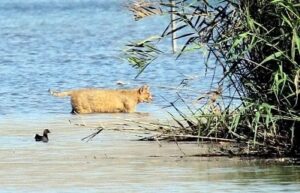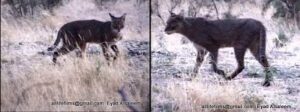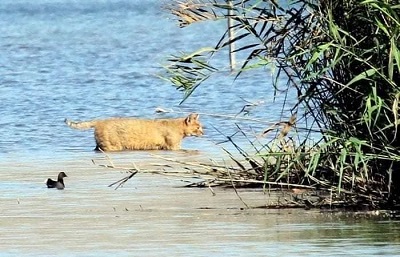Written by: Mahmoud Abdel Latif
This article is quoted from Raseef website - link to the original article published on Monday, February 19, 2024 here
The war cast its shadow on the wildlife in the eastern region of Syria, and a large number of cases of carnivores approaching animals such as wolves and hyenas from population centers were recorded, which was a rare occurrence in the years before the war, and the explanation for this according to the local population is due to research on these animals. What to eat, after many of them avoided roaming with herds of livestock in desert areas or far from gatherings due to fear of mines and combat operations.
Except that felines that were thought to be extinct, such as the tiger or the Euphrates cheetah, have reappeared in areas near villages in the Euphrates Basin and the Syrian Jazira, and these are animals that published information indicates that they are “threatened with extinction.” The Euphrates tiger or leopard are two common names for the same creature that lives in this distinctive region of Syrian geography.
Seeing this animal is rare, and I encountered it once while collecting fish from the dam lake.
Appear again
Fayez Al-Jaddou lives in the village of Ajaja in the southern countryside of Hasakah. He told Raseef22: “At first I used to call the tiger or the Euphrates cheetah a wild cat, as it looks exactly like a cat, much larger in size. Residents of the area near the Khabur River, which flows into the Euphrates near the city of Al-Mayadeen, used to kill this animal in their belief that it was a danger to the poultry birds they raised or even livestock, and although no cases of it entering the villages were recorded, unlike wolves and hyenas, hunters or others They shoot directly at him as soon as he sees him.”
He continued: “The war and continuous fighting near the Euphrates River, and the continuous shooting operations on the river basins or islands, as they are suspicious places for the forces controlling both sides of the river, are the reason that pushed the Euphrates tiger to migrate towards less noisy areas, such as the Khabur River Basin, which despite Since it has turned into a seasonal river with water pools remaining in the deep areas of its course, it still contains fish and an acceptable plant density, and small animals such as rabbits, field mice and the like live near it, and these are animals that the Euphrates tiger lives on by hunting.”

Fisherman Youssef Al-Salama, who mainly works in fishing from the Southern Dam Lake in Al-Hasakah Governorate, told Raseef22 that seeing this animal is rare, and he encountered it once during the process of collecting fish from the Southern Dam Lake, when he saw it on the body of the dam, which was made of basalt stones, when he was He catches the fish that rest between these stones. He also lives on the small islands that exist within the lake, especially those where the reeds are dense. He was spotted on one of these islands hunting partridges.
He added: “There are those who kill the animal on suspicion that it is a predator or a danger, and it usually flees quickly if it senses the presence of humans close to it. Some elderly people say that they saw the tiger or the Euphrates leopard chasing wild rabbits in some areas near the Khabur River when the river’s condition was better.” In terms of water levels and flow, but now it approaches bodies of water only to catch fish or pick up dead ones. It is an animal that apparently can swim, but no one has seen it swim.”
Other narratives
Some unwritten stories say that residents in the Euphrates Basin areas were raising cheetahs and tigers in their homes, and the process begins by searching for the nests of these animals on the river islands known as “Al-Hawaij,” in Deir ez-Zor and Raqqa, and then capturing small chicks and raising them on cow’s milk. And boiled meat, while preventing them from eating raw meat for fear of them turning into ferocious animals when they reach adulthood.
These animals are then trained to carry out hunting operations by pursuing wild animal prey, such as rabbits, or even desert foxes, which are known locally as “Al-Hussaini,” and in other regions as “Al-Jaqal.”
However, this narrative is not proven locally, as the question about it among the residents of the region is answered with, “It is said that the matter is true,” and the matter is likely to happen in comparison with the experience of raising birds of prey, such as the peregrine falcon, and training them to hunt game.
There are those who kill the animal on suspicion that it is a predator or a danger, and it usually flees quickly if it senses the presence of humans close to it. Some elderly people say that they saw the tiger or the Euphrates leopard chasing wild rabbits in some areas near the Khabur River when the river’s condition was better in terms of its level. Water
The information available about the Euphrates tiger or leopard, in online research references, says that they are two similar animals in terms of physical structure. The height of each reaches 60 centimetres, and the body length reaches 90 centimetres, while the length of the tail is at most 30 centimetres. The difference is The only thing between them is colour. The tiger is the striped one for the population, and the leopard is the spotted one, and the matter is measured by the general characteristics of the animals that bear the same two names in Africa and elsewhere.
Tigers, but smaller
Raseef22 contacted environmental researcher Iyad Al-Salim, who answered questions related to these two animals: “The Euphrates tiger is present in large numbers in the areas of the river islands in the Euphrates River, which are popularly known as Al-Hawaij, but it is rarely spotted by residents, because it has adapted its life to hunting. Fish and waterfowl at night, especially the bird popularly known as the waterbird. It lies in wait for the birds and moves with the same agility as a tiger to carry out the process of pouncing on the prey with great speed. It also feeds on the fish that rest among the river reeds at night, so that on some occasions it does not bother itself with hunting because there “A lot of dead fish on the banks of the islands in the Euphrates River.”
Thus, the lifestyle of the Euphrates tiger made it invisible even to fishermen working in the Euphrates River, but there are fishermen who have confirmed several times that it has been seen in large numbers.

The Euphrates tiger is a distinct type of feline, as Al-Salim points out. It descends from a subspecies of felines or from independent species. It is distinguished by the patterns on its body, which are not very clear, and there is no contrast between the patterns on the body and the colors of the surroundings. Rather, it can be said that there is a kind of merging. The color between him and his location helps him hide among the reeds that grow on the banks of the river islands.
The researcher who conducted field monitoring of the Euphrates leopard in 2004 on the river islands of the Euphrates River within Raqqa Governorate denies that there is a difference between the Euphrates leopard and the Euphrates leopard, as he considers them to be two names for the same animal. During the exploration process he carried out, he studied the behavior of the Euphrates leopard and monitored its movements for an entire month. It turned out that it could be called the names of smaller cats, such as the lynx, but the use of the name Euphrates tiger came to be adopted by the population.
The reason for killing the Euphrates tiger is due to the lack of environmental awareness among the population, and perhaps their fear of it can be linked to its name associated with horror as a result of wildlife films, so the direct reaction is to shoot it, but these animals are very beneficial to the environmental balance in the region, and serve humans by killing Snakes and rats
He adds: “The Euphrates tiger is characterized by a way of walking that is completely similar to that of a tiger, and from a distance it appears through its movement behavior as one of the large tigers, but upon approaching it we discover that it is small in size.
The Euphrates tiger is not a dangerous animal. It is one of the cowardly animals that immediately flees when it senses any movement close to it. During our attempt to monitor it, it did not approach humans despite attempts to lure it with fish or meat. And even if it approached population centers in search of food, it was not... Harmful, but this rarely happens because they depend on foods that are easy to obtain.”
Killing him is a common mistake
The reason for killing the Euphrates tiger, according to Al-Saleem, is due to the lack of environmental awareness among the population, and perhaps their fear of it can be linked to its name associated with horror as a result of wildlife films, where the tiger appears to be a dangerous animal, so the immediate reaction is to shoot it, but these animals are very useful. For the environmental balance in the region, it serves humans by killing snakes and rats and preying on them if they happen to be present. There is no confirmation of any story being circulated of any of these tigers attacking any human being in the region.
This information is accompanied by the absence of statistics or effective studies about this animal in the specialized institutions such as the agricultural directorates or the environment directorates in the eastern region of Syria. There are individual attempts to study and count this animal, as is the case with the rest of the wild animals that are settled or migratory in Syria, as there are no There are censuses or studies that are approved or can be built upon in these institutions, and this is not a conclusion, but rather the summary of a question from a large number of sources in the three eastern governorates, namely Al-Hasakah, Raqqa, and Deir ez-Zor. Even some agricultural engineers and veterinarians in the region denied the existence of an animal with this name. They considered it to be a lynx with different colors than the traditional lynx.
Regardless of whether it is called a tiger or a cheetah in society, its life must be documented and presented in the correct scientific form, and the laws regulating the hunting of wild animals must be strictly applied, so that this animal is protected from useless killings, as its killing occurs merely because of a common illusion of its brutality, as His bodies are often left in the open, according to residents, which increases environmental risks in an area that can be described as “neglected” since before the war in Syria.





